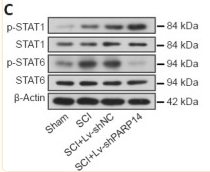STAT6 Antibody - #AF6302
Product Info
*The optimal dilutions should be determined by the end user.
*Tips:
WB: For western blot detection of denatured protein samples. IHC: For immunohistochemical detection of paraffin sections (IHC-p) or frozen sections (IHC-f) of tissue samples. IF/ICC: For immunofluorescence detection of cell samples. ELISA(peptide): For ELISA detection of antigenic peptide.
Cite Format: Affinity Biosciences Cat# AF6302, RRID:AB_2835151.
Fold/Unfold
12S1644; D12S1644; IL 4 STAT; IL-4 Stat; IL4 STAT; Interleukin 4 Induced; Interleukin 4 Induced Transcription Factor IL4 STAT; Signal transducer and activator of transcription 6; Signal Transducer And Activator Of Transcription 6 Interleukin 4 Induced; Signal Transducer And Activator Of Transcription 6 Nirs Variant 1; Signal transducer and activator of transcription 6, interleukin 4 induced; STAT 6; STAT interleukin4 induced; STAT, interleukin4 induced; Stat6; STAT6_HUMAN; STAT6B; STAT6C; Transcription factor IL 4 STAT;
Immunogens
- P42226 STAT6_HUMAN:
- Protein BLAST With
- NCBI/
- ExPASy/
- Uniprot
MSLWGLVSKMPPEKVQRLYVDFPQHLRHLLGDWLESQPWEFLVGSDAFCCNLASALLSDTVQHLQASVGEQGEGSTILQHISTLESIYQRDPLKLVATFRQILQGEKKAVMEQFRHLPMPFHWKQEELKFKTGLRRLQHRVGEIHLLREALQKGAEAGQVSLHSLIETPANGTGPSEALAMLLQETTGELEAAKALVLKRIQIWKRQQQLAGNGAPFEESLAPLQERCESLVDIYSQLQQEVGAAGGELEPKTRASLTGRLDEVLRTLVTSCFLVEKQPPQVLKTQTKFQAGVRFLLGLRFLGAPAKPPLVRADMVTEKQARELSVPQGPGAGAESTGEIINNTVPLENSIPGNCCSALFKNLLLKKIKRCERKGTESVTEEKCAVLFSASFTLGPGKLPIQLQALSLPLVVIVHGNQDNNAKATILWDNAFSEMDRVPFVVAERVPWEKMCETLNLKFMAEVGTNRGLLPEHFLFLAQKIFNDNSLSMEAFQHRSVSWSQFNKEILLGRGFTFWQWFDGVLDLTKRCLRSYWSDRLIIGFISKQYVTSLLLNEPDGTFLLRFSDSEIGGITIAHVIRGQDGSPQIENIQPFSAKDLSIRSLGDRIRDLAQLKNLYPKKPKDEAFRSHYKPEQMGKDGRGYVPATIKMTVERDQPLPTPELQMPTMVPSYDLGMAPDSSMSMQLGPDMVPQVYPPHSHSIPPYQGLSPEESVNVLSAFQEPHLQMPPSLGQMSLPFDQPHPQGLLPCQPQEHAVSSPDPLLCSDVTMVEDSCLSQPVTAFPQGTWIGEDIFPPLLPPTEQDLTKLLLEGQGESGGGSLGAQPLLQPSHYGQSGISMSHMDLRANPSW
Predictions
Score>80(red) has high confidence and is suggested to be used for WB detection. *The prediction model is mainly based on the alignment of immunogen sequences, the results are for reference only, not as the basis of quality assurance.
High(score>80) Medium(80>score>50) Low(score<50) No confidence
PTMs - P42226 As Substrate
| Site | PTM Type | Enzyme | Source |
|---|---|---|---|
| S2 | Acetylation | Uniprot | |
| S2 | Phosphorylation | Uniprot | |
| S8 | Phosphorylation | Uniprot | |
| K9 | Ubiquitination | Uniprot | |
| K107 | Ubiquitination | Uniprot | |
| K108 | Ubiquitination | Uniprot | |
| K124 | Ubiquitination | Uniprot | |
| K129 | Ubiquitination | Uniprot | |
| K252 | Ubiquitination | Uniprot | |
| K277 | Ubiquitination | Uniprot | |
| K284 | Ubiquitination | Uniprot | |
| K288 | Ubiquitination | Uniprot | |
| K307 | Ubiquitination | Uniprot | |
| K319 | Ubiquitination | Uniprot | |
| K361 | Ubiquitination | Uniprot | |
| S407 | Phosphorylation | Q9UHD2 (TBK1) | Uniprot |
| K450 | Ubiquitination | Uniprot | |
| K504 | Ubiquitination | Uniprot | |
| T525 | Phosphorylation | Uniprot | |
| K595 | Ubiquitination | Uniprot | |
| K613 | Ubiquitination | Uniprot | |
| K621 | Ubiquitination | Uniprot | |
| K630 | Ubiquitination | Uniprot | |
| K636 | Ubiquitination | Uniprot | |
| Y641 | Phosphorylation | Q9UHD2 (TBK1) | Uniprot |
| T645 | Phosphorylation | Uniprot | |
| K647 | Ubiquitination | Uniprot | |
| S707 | Phosphorylation | P45983 (MAPK8) | Uniprot |
| S756 | Phosphorylation | Uniprot | |
| S817 | Phosphorylation | Uniprot |
Research Backgrounds
Carries out a dual function: signal transduction and activation of transcription. Involved in IL4/interleukin-4- and IL3/interleukin-3-mediated signaling.
Tyrosine phosphorylated on Tyr-641 following stimulation by IL4/interleukin-4. Tyrosine phosphorylated following stimulation by IL3/interleukin-3 (By similarity). Dephosphorylation on tyrosine residues by PTPN2 negatively regulates the IL4/interleukin-4 mediated signaling.
Mono-ADP-ribosylated by PARP14.
Cytoplasm. Nucleus.
Note: Translocated into the nucleus in response to phosphorylation.
Forms a homodimer or a heterodimer with a related family member (By similarity). Interacts with NCOA1 via its C-terminal LXXLL motif.
Belongs to the transcription factor STAT family.
Research Fields
· Cellular Processes > Cell growth and death > Necroptosis. (View pathway)
· Environmental Information Processing > Signal transduction > Jak-STAT signaling pathway. (View pathway)
· Human Diseases > Infectious diseases: Viral > Hepatitis B.
· Human Diseases > Cancers: Overview > Pathways in cancer. (View pathway)
· Human Diseases > Immune diseases > Inflammatory bowel disease (IBD).
· Organismal Systems > Immune system > Th1 and Th2 cell differentiation. (View pathway)
· Organismal Systems > Immune system > Th17 cell differentiation. (View pathway)
References
Application: WB Species: Mouse Sample:
Application: WB Species: Mouse Sample: raw264.7 cells
Application: WB Species: mouse Sample: RAW264.7 cells
Restrictive clause
Affinity Biosciences tests all products strictly. Citations are provided as a resource for additional applications that have not been validated by Affinity Biosciences. Please choose the appropriate format for each application and consult Materials and Methods sections for additional details about the use of any product in these publications.
For Research Use Only.
Not for use in diagnostic or therapeutic procedures. Not for resale. Not for distribution without written consent. Affinity Biosciences will not be held responsible for patent infringement or other violations that may occur with the use of our products. Affinity Biosciences, Affinity Biosciences Logo and all other trademarks are the property of Affinity Biosciences LTD.



